City Fighting County on Rapid Transit
Council committee puts restrictions on BRT project, charges county acted in bad faith.
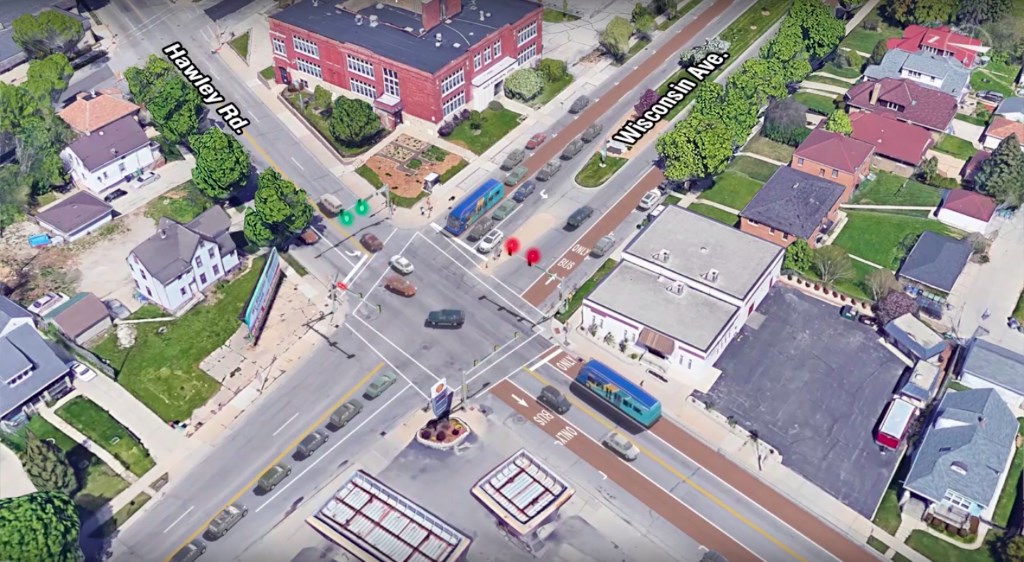
Conceptual rendering of the BRT line at the Wisconsin Avenue and Hawley Road intersection. Image courtesy of Milwaukee County Transit System.
There is no love lost between the Milwaukee Common Council and Milwaukee County regarding the county’s East-West Bus Rapid Transit proposal.
Last July the city approved a resolution that advanced the project and allowed the county to apply for a federal grant for the approximately nine-mile long project. But the resolution came with a few caveats that restricted the use of parking lanes as dedicated lanes in specific areas and requested that the county keep the city in the loop regarding project design and engineering. Still, the project seemed poised to advance with relative ease.
Flash forward a a year and aldermen Michael Murphy and Robert Bauman are arguing that the project team “has broken good faith” in designing and engineering the project. The two council members, who represent the areas the route would run through, are co-sponsoring a resolution that would further clarify the city’s position on the project and all-but eliminate the potential of dedicated lanes on W. Bluemound Rd. The proposal had a public hearing at Wednesday’s meeting of the council’s Public Works Committee.
Bauman, a long-time public transit supporter and rider, isn’t outright opposed to the project, but clearly outraged by the county’s engagement with the city on the project. He characterized the BRT project’s design as “very narrow and shortsighted” and noted “we have boxed ourselves into a bus-only, street-only corridor.”
The alderman stated “on my recent trip to Cleveland where I rode bus rapid transit ad nauseum, I learned, I think, we’re putting bus rapid transportation on the wrong corridor.” In an interview after the hearing Bauman suggested that a study should have been done on the cost of creating a route parallel with the Canadian Pacific railroad tracks starting at N. 38th St. and ultimately running to the Wauwatosa Village. He noted that a similar route was proposed when a regional light rail system was discussed in the 1990s.
Bauman also expressed frustration during the interview that the county is not working with the city on a planned state-funded rebuild of W. Wisconsin Ave. The rebuild is expected to occur next year and could include separation for the dedicated lanes and relocated medians, but the Bus Rapid Transit project team is not actively engaged in planning that redesign.
The transit-riding alderman noted that he was open to having dedicated lanes for the project from N. 8th St. to N. 38th St. along W. Wisconsin Ave. and on Wisconsin Ave east of the Milwaukee River. He noted that “the best example of BRT in the country, the Health Line in Cleveland is 40 percent shared lanes, 60 percent dedicated lanes.” Murphy and Bauman both noted that the Milwaukee system could achieve 50 percent dedicated lanes.
Murphy, who represents the western portion of the proposed route through the city, wasn’t as fiery as Bauman in his comments (few council members are), but clearly isn’t happy with how things have gone, either. He noted he has attended all of the public hearings on the project and held a number of meetings with neighborhood and business organizations along the route. Regarding a project designed to move thousands of people daily, he stated: “I’m very concerned about the potential impact on the ability of residents to move in this corridor.” In particular, Murphy said he learned in a meeting with executives of the Hal Leonard Corporation, the nationally-known producer of sheet music, that the company might move due to the project’s impact on pullout times for employees from its parking lot onto Bluemound Rd., which could increase from three minutes to six minutes. The firm employs approximately 150 people at 7777 W. Bluemound Rd.
Representing the county was project consultant Ashley Booth of HNTB. Booth had to perform a delicate dance on the issue because he also works for the city as a consultant on the streetcar project. But his relationship with the city didn’t appear to earn him any protection: at one point Bohl suggested the firm should be fired for studying dedicated lanes in an area the city had previously expressed opposition to them. Bohl noted “you had the red flashing light and you decided to go.”
Booth, in his response to the issues raised by Bauman, noted that city engineer Jeff Polenske was a committee member on a feasibility study for the project. Booth noted that this study did engage in mode analysis and studied other options including light rail and commuter rail, but ultimately settled on bus rapid transit. He told the committee the project team has worked extensively with area stakeholders along the route.
Committee member Ald. Nik Kovac weighed in on the measure, stating “I don’t think anyone should complain we have ruined public transit by putting in local neighborhood conditions.” He noted that the streetcar project went through a similar process in routing around the most utility-laden streets in Downtown. After questioning if the county “has been a partner in good faith,” he opened the door to a future solution by noting “anything the council does we can undo.”
Committee chair Mark Borkowski, who was the lone alderman to vote against the proposal last year, was largely silent on the matter during today’s hearing.
The only member of the public to speak at the hearing was Karyn Rotker of the American Civil Liberties Union. Rotker asked the committee to hold the measure citing that the public was largely unaware of the proposal. While Bauman applauded her years of advocacy for public transportation, he quickly moved to vote on the measure, noting that holding the measure would push it back to September following an August council recess.
The four committee members in attendance unanimously approved the resolution. Alderman Bob Donovan had earlier left the meeting. It will go before the full Common Council on July 31st.
Though it was not discussed at the hearing, the legislation that was passed also contains a provision that the city “shall not incur any direct or indirect expenses” related to the development or operation of the system. This language is similar to legislation passed by Milwaukee County about the Milwaukee Streetcar.
Route Map
About the Bus Rapid Transit Proposal
The roughly nine-mile, 12-stop line would run from the site of the proposed The Couture tower on the lakefront and west on Wisconsin Ave. to Hawley Rd., and then along Bluemound Rd. before snaking through the Milwaukee Regional Medical Center to a park-and-ride lot on N. Swan Blvd.
The project has an estimated cost of $48 million. It is estimated it would be 80 percent federally funded. The system would be operated by the Milwaukee County Transit System.
Gains in ridership are expected to come from high frequency of services (every 10 minutes on weekdays, every five minutes during rush hours), fewer stops and off-bus ticketing (both leading to reduced travel time), better stations than traditional bus shelters and improved vehicles that would cost upwards of $1 million each. According to a study by the county the corridor would have considerable benefits for nearby residents: 23 percent of those living within a half-mile of the route lack an automobile in their household, far above the county average, statistics show. Along the route are major employment and job centers including Downtown (81,000 jobs, 25,000 residents), near West Side (40,000 residents, 30,000 jobs) and Milwaukee Regional Medical Center (16,000 jobs, 30,000 daily visitors).
The proposal will ultimately need the cooperation of both Milwaukee and Wauwatosa to secure dedicated lanes and stop locations.
If you think stories like this are important, become a member of Urban Milwaukee and help support real independent journalism. Plus you get some cool added benefits, all detailed here.
More about the East-West BRT Line
- Transportation: Off-Board Fare Collection Begins on Connect 1 - Graham Kilmer - Apr 16th, 2024
- Streetcar Begins Daily Service To The Couture, BRT Will Soon Follow - Jeramey Jannene - Apr 11th, 2024
- Transportation: Connect 1 Ridership Continues to Grow - Graham Kilmer - Nov 23rd, 2023
- Transportation: Battery Electric Buses Will Return This Fall - Graham Kilmer - Sep 8th, 2023
- Transportation: MCTS Pulling New Battery Electric Buses From the Road - Graham Kilmer - Aug 24th, 2023
- MKE County: Local Leaders Celebrate Launch of BRT Service - Graham Kilmer - Jun 5th, 2023
- Transportation: Milwaukee’s First Bus Rapid Transit Line Is Open for Business - Graham Kilmer - Jun 4th, 2023
- Transportation: New Bus Rapid Transit Line Launches Sunday, GoldLine Ends - Graham Kilmer - Jun 3rd, 2023
- Transportation: Federal Funds Creating Two New East-West BRT Stations - Graham Kilmer - May 19th, 2023
- Transportation: First 4 Months of BRT Rides Will be Free - Graham Kilmer - May 9th, 2023
Read more about East-West BRT Line here
Political Contributions Tracker
Displaying political contributions between people mentioned in this story. Learn more.
- March 31, 2018 - Bob Donovan received $50 from Mark Borkowski
- March 22, 2017 - Robert Bauman received $50 from Ashley Booth
- May 19, 2016 - Robert Bauman received $100 from Ashley Booth
- February 11, 2016 - Nik Kovac received $50 from Jeff Polenske
- September 8, 2015 - Bob Donovan received $50 from Mark Borkowski
- May 7, 2015 - Nik Kovac received $100 from Ashley Booth
- April 14, 2015 - Robert Bauman received $100 from Ashley Booth
- September 10, 2014 - Robert Bauman received $50 from Ashley Booth
Eyes on Milwaukee
-
Church, Cupid Partner On Affordable Housing
 Dec 4th, 2023 by Jeramey Jannene
Dec 4th, 2023 by Jeramey Jannene
-
Downtown Building Sells For Nearly Twice Its Assessed Value
 Nov 12th, 2023 by Jeramey Jannene
Nov 12th, 2023 by Jeramey Jannene
-
Immigration Office Moving To 310W Building
 Oct 25th, 2023 by Jeramey Jannene
Oct 25th, 2023 by Jeramey Jannene
Transportation
-
Congestion Pricing Cuts Air Pollution in New York City
 Dec 14th, 2025 by Jeff Wood
Dec 14th, 2025 by Jeff Wood
-
FTA Tells Milwaukee to Crack Down on Fare Evasion — Even Where Fares Don’t Exist
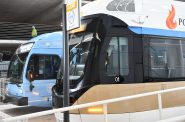 Dec 12th, 2025 by Graham Kilmer
Dec 12th, 2025 by Graham Kilmer
-
Will GOGO’s Bus Service Ever Get Going?
 Dec 9th, 2025 by Jeramey Jannene
Dec 9th, 2025 by Jeramey Jannene


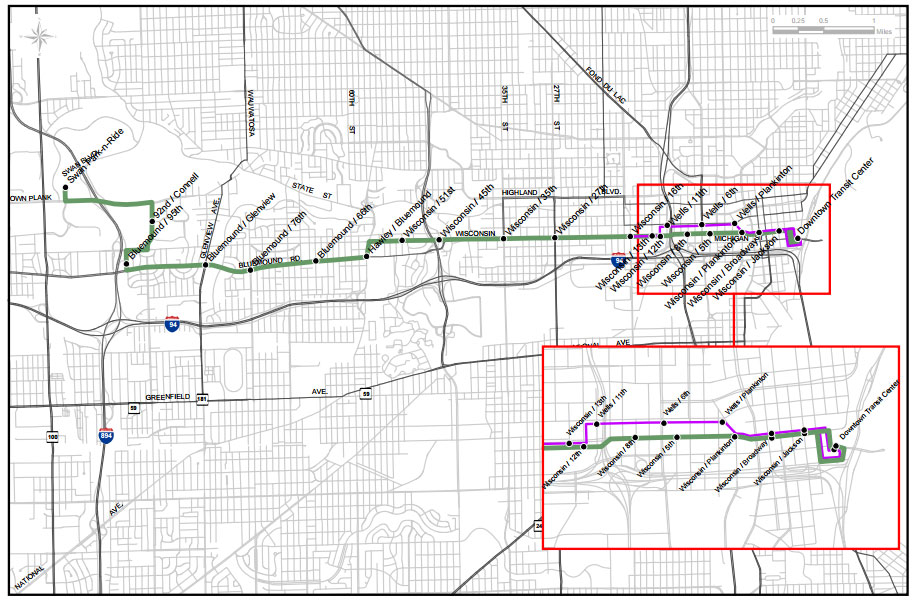






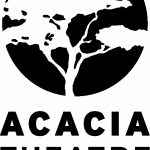



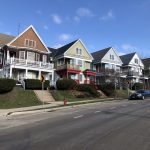





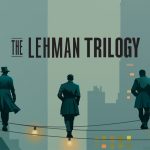

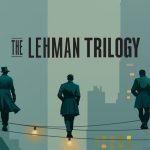

The Alderman is sore about not getting light rail. He knows damn well that without dedicated lanes there might as well be no BRT. Cleveland is not the best BRT in the country because of a lack of dedicated lanes, it works in spite of this limitation and because there is almost no BRT in the United States to compare it to. This absurd red herring about parking is going to kill the one viable option for rapid (and possibly regional) transit we have on the table and are likely to have on the table for the foreseeable future. The East West Corridor is by far the most logical place for such a system and given that much of the route passes through portions of the city with some of the lowest car ownership per capita and among the highest transit ridership it’s the city’s poorest that will pay the price for the city once again bickering itself into non-action.
Hal Leonard is going to move because pull out times are forecast to be from 3 minutes to 6 minutes? That is ridiculous. I would survey the workers, not the two executives that you had beers with and made tongue in cheek jokes with, then decided it would be a real argument. Like the commentator above, I smell salmon bait!!!!! My guess is that folks working at Hal Leonard are 99% excited about this project.
What is the alternate route that Ald. Bauman is referencing? Something about the Canadian Pacific Rail Line beginning at 38th Street? Is there a map anyone can point to that shows this route?
Also, Mr. Hillard is correct. BRT without dedicated lanes is no longer BRT. We also don’t have real BRT in this country to compare it to. You need to go to Latin America to see how actual BRT is implemented and operated (I’ve experienced Lima, Peru’s line, but there are many other good examples). This will end up being a watered down and ineffective version of BRT if we keep going down this path. It will probably be slightly better than the “express” lines MCTS already has, which are only slightly better than the regular routes.
I find this all quite amusing. The county and the city wasting taxpayer dollars on the BRT and the trolley which are both doomed to fail. Punish businesses along the BRT route by taking away the street parking making it more difficult for customers to access those businesses. Then build the trolley to nowhere which will never produce enough revenue to sustain itself. Can’t these morons take a step back and see how ridiculous these two projects truly are?
@Dan – Yeah, I’m confused by Bauman’s reference to the CP rail line as well. There’s the active CP main line that runs essentially parallel to State St. west of Miller Valley to Tosa but it certainly does not look like there is adequate space along there for a busway (or light rail tracks, for that matter).
Anyway, I’m less troubled by the possible lack of dedicated lanes along Bluemound Rd. than I am about the lack of lanes farther east where buses are often delayed because of congestion (essentially in and near downtown). If bus lanes are a “no go” along Bluemound, the combination of transit signal priority and bus bulbs/curb extensions at bus stops (so buses are not delayed pulling out of stops) ought to provide reasonably improved service in that area.
Bob there’s no trolley. There’s a streetcar. If you are going to make puerile insults at least be accurate.And if Kansas City can build a successful streetcar, so can we. You can always move to West Bend or something if city life is too much for you.
Playing politics with people’s livelihoods. This about people getting better access to jobs in other parts of our area who do not have the private transportation to do so.
Vincent Hanna is right…I would guess that the people that call streetcars, trolleys, are probably the same people that call trains, choo choos. I won’t even engage someone that talks baby talk when trying to discuss the merits of something as basic as mass transit. It’s embarassing….for them.
Bob, while it’s true the streetcar will not collect enough fare revenue to cover operating expenses, neither do buses (or highways).
Other than the one-time cost of building infrastructure (basically the tracks, the electrical system, and a facility for maintenance and overnight storage), streetcars should cost the same or less than buses to operate and maintain while providing cleaner, quieter and smoother transit.
Even vehicle costs are similar when you factor in the fact that streetcar vehicles last for decades compared to 10-15 years for buses. A streetcar vehicle costs $4 million compared to to $1.15 million for a diesel-electric hybrid bus with half the passenger capacity and a much shorter useful lifespan.
While MCTS needs operating funds from Madison and from County property taxes (MCTS fares cover only 27.5% of operating costs), streetcar operations (after the first 18-36 months, which will be subsidized by Washington) will not be funded from any tax source—it will use increased parking revenue (meter fees, fines, etc) instead.
The Twin Cities have BRT routes that are working effectively. What’s more the light rail and BRT systems have generated significant economic development along the routes.Between increased ridership and economic development the systems have generated a healthy ROI.
Ald. Baumann has gone all in on the streetcar, so much so that BRT would be perceived by him to be competition for the streetcar.
How about booting all the male committee members snarling at each other about this and let the women get this project working. These guys don’t seem to be paying attention to anything anyone else says unless it’s to argue, compare size and swing appendages. Lovely (not) to hear that Ms. Rotker from the ACLU was basically shut down by Donovan, when she had a really valid point. Guess it was too much for him. What a load.
Proposed Couture?
Isn’t that thing built yet?
We seem to have been talking about it since before Henry Maier was mayor.
mike drew
If Mike Drew was mayor there would be at least two Couture’s built and open by now.
Wow Jan, you’ve got some real man hate going on. I hope you can work through that.
Don’t worry Jan AG will mansplain things for you. What night of the week does your Men’s Rights group meet AG?
Hahaha, Vincent… you’re one of “those” people too? Not surprising…
I don’t know what that means. I’ve had some online encounters with men’s rights guys. They are unpleasant, to put it mildly. Your post at 8:33am sounds just like them. You come across like a mansplaining dick (not surprising). I don’t know why you feel so threatened by a woman saying women should have more of a say on issues like this.
I think Jan loses the meaning of her message by describing the politicians in this case as some sort of “snarling” group of cave men and giving undue focus and scrutiny to their “appendages.”
Usually I find it’s best when you’re trying to fight perceived gross generalizations or prejudices that you don’t do it through gross generalizations and prejudices. But hey, maybe that’s just me…
But look at your response to her. Instead of saying what you just said to me, you say “Wow Jan, you’ve got some real man hate going on. I hope you can work through that.” So you resort to gross generalizations and suggest she has problems to work through. That makes you part of the problem and completely contradicts your claim of disliking “gross generalizations or prejudices.”
I invite you to reconsider your view on that point. I didn’t say all women have man hate problems, nor did I assume she had man hate problems simple because she was a woman. I based it on her comment earlier where she spews… well… man hate. Not much more I can do with that.
I invite you to reread her comment. She doesn’t say she hates men. She chastises the male committee members, including one for shutting down someone else as they tried to make a comment. That’s a tiny amount of men that she believes were behaving poorly. And out of that you get she hates men? If anyone needs to reconsider a viewpoint here it’s you.
Nope, her comments were pretty sexist and a textbook example of misandry. If I made comments like that, but it was about women, you’d be signing a very different tune right now.
You did make a comment like that about a woman. A woman you don’t know objected to the behavior of a handful of men and you immediately label her a man-hater. That’s textbook misogyny.
Well this gave me a good chuckle this morning. Thanks for that, Vincent!
You think misogyny is funny. Not surprising. You can get back to your Men’s Rights meeting now.
Do any of you even live on the proposed line? I do and guess what, we are not amused. This may shave time from the riders commutes but it will add to mine. In addition, I have children that will no longer be able to ride their bikes at all anywhere near our home when traffic backs up n our neighborhood from accidents on the freeway and ball games at Miller Park. Cars already fly down our streets to get around traffic from time to time, this will make it a daily occurrence. Our government is supposed to work for us ALL. We have few opportunity to have our voices heard when meetings are held at times when people cannot attend. When we were able to attend and ask questions or voice concerns we were unheard and treated as though our opinions were unimportant. Politics is what this is about, plain and simple. We are out as soon as we can. My family is my first priority. Go ahead and argue over the opinions here. If you don’t live here OR will never ride the BRT you are politicizing something really does affect the lives of real people and families. Yes, the neighborhoods affected do matter…those of us who live here matter as much as those that already commute via bus down Wisconsin Ave. now.
@Bennett – I live a few blocks off the proposed line and frequently take the bus downtown. A true BRT on this route would be welcomed by me, a neighbor and rider. I also know many of my neighbors also take the bus to work downtown. I don’t understand the connection between BRT and cars flying down the street and endangering your family. You’re saying people will be driving faster on your side street because of a transit improvement on Bluemound? Seems like a thin connection.
@Dan your comments are welcomed since you are a rider and also live in the neighborhood. The connection I was referring to is currently, when traffic conditions are at their worst like during ball games or freeway congestion, commuters use Bluemound road as an alternate route. When that backs up they often fly down side streets and use our neighborhood between Bluemound and Wisconsin. The bus line would remove a lane in each direction and during peak times increase the bus frequency. This will add to the congestion and will cause even more of the same. I am pretty sure if you live on the route you would already be experiencing this traffic so it is not something I am making up to prove some point.
I don’t ride the bus at all. The bus route currentlyI goes through my neighborhood but I don’t work anywhere near where the bus travels, nor does my spouse. My lack of ridership might be why I don’t understand the problem with the current bus routes. Maybe you can convince me why a replacement route is needed and if the cost to all involved is justified? If it is to shave time off your commute to downtown that is just not fair to the rest of us on that route. I am open to your comments and whole heartedly believe in your right to have your opinion. Please understand I have many problems with this proposed bus line, the safety issue is the most important, and that my reasons for not wanting it are just as valid as yours.
@Bennett – I appreciate the congenial conversation as that is fairly uncommon on article comment threads (see above). My main reasoning for improved transit service in this corridor is that our neighborhoods happen to be between the two largest employment centers in the State of Wisconsin (Downtown MKE and the County Grounds). That, in part, is a reason why my family decided to purchase a home where we did.
However, while downtown Milwaukee and its many jobs are well connected via transit to multiple parts of the city, the county grounds are relatively isolated from transit. The only lines that go to the County Grounds are the Gold Line and route 31 (not a full-service line). This means anyone who would like to access the many jobs at the County Grounds without a vehicle is facing an hour or more commute via public transit for a place that is geographically located in the center of our metro area. Anything we can do to better connect that job center and its many services to job seekers in the City of Milwaukee should be considered heavily. In my opinion, if that means slightly inconveniencing commuters on Bluemound Road, I’m all for it.
That said, residents who live along the route should be heard. However, to date, I haven’t heard residents along the route bring up any valid reasons for not putting in the BRT route. The reasons I have heard include increased congestion (I don’t see how another non-personal vehicle travel option would actually cause more congestion as it gives people an option to leave their cars at home), increased crime (this is ridiculous), and loss of parking (I can understand this argument more from businesses, but personal homes in the Bluemound corridor all have off street parking and, if not, plenty of parking is available on side streets). Your concern about cut-through traffic is legitimate but could be addressed with other traffic calming measures on side streets.
Just my two cents.
I wonder if the use of small traffic islands in intersections and chicanes (and similar traffic calming measures) would address concerns of cut-through traffic on side streets. Essentially, design the streets to make it awkward to use them as through streets and especially to make it difficult to drive at unsafe speeds. And perhaps look at temporary gates or barriers in a few select locations that would be closed on ballgame days to further discourage heavy traffic and reckless motorist behavior on side streets.
Has either the city with its streetcar or the county with Bus Rapid Transit given any thought to bicyclists? Lately, as I am attempting to go from my place on the East Side to Avenues West, I’m dealing with detour upon detour. Because of streetcar construction, the Ogden Ave. bike lane is lost. and because of BRT, we might have to forget about any bike lanes on either Bluemound RD. or Wisconsin Ave.
@Barry In fact, the streetcar project includes new bike lanes as part of the project.